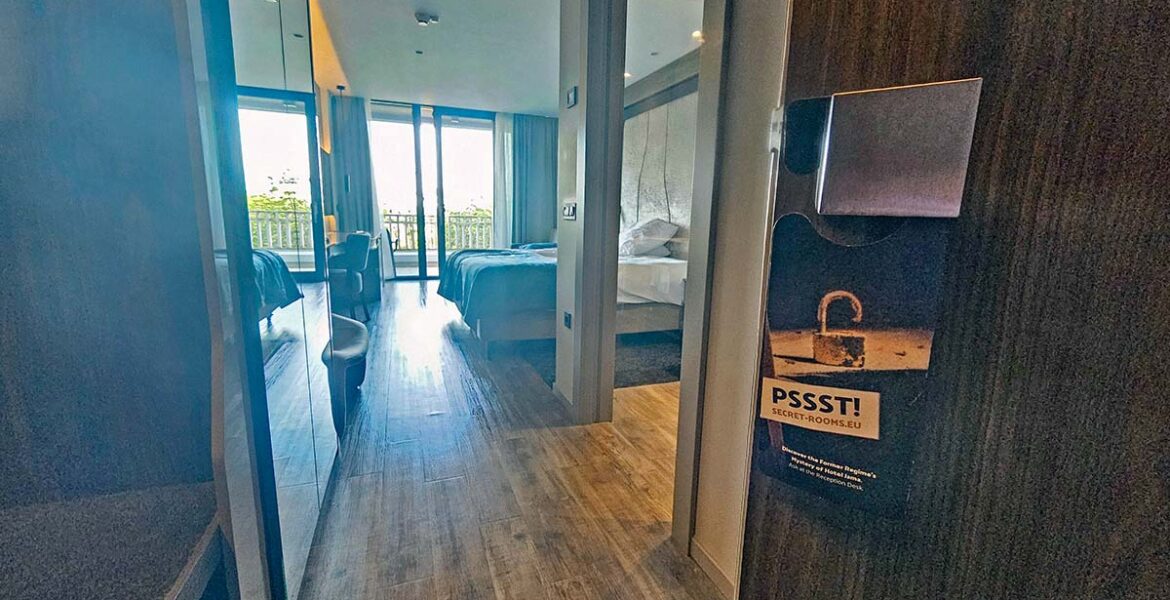Do you ever enter a hotel, and then have trouble finding the room they assigned to you? Hotel corridors can sometimes resemble a maze, and navigational numbers signposted on walls can be not helpful. Walking through Hotel Jama in Postojna, Slovenia, I couldn’t shake the feeling that some rooms were… missing.
Sure, odd numbers on one side, even on the other – a perfectly logical setup. Yet, something still seemed off. Since this was not my first visit (I had already dropped by when I explored the jaw-dropping Predjama Castle nearby), I knew Hotel Jama had “Secret Rooms”. But still, the room number layout in this iconic Slovenian hotel was playing games with my mind.
Hotel Jama, at the entrance of the equally enigmatic Postojna Cave, seemed like it wanted me to play a game
“Do you miss some room numbers?”, I asked at the front desk, thinking that surely there had to be some explanation for it, such as “Yes, we avoid the unlucky number 13” (or 4, if they would be in the Chinese area of influence). I was expecting, at least, “Yes, we combined two rooms into one during the renovation, but we didn’t change the lettering”. I didn’t hear these answers. Instead…
“Oh?”, the receptionist’s eyebrow arched high, as I tried to explain my mathematical confusion.
I got her to confirm that, indeed, some room numbers might be missing in certain hotel areas. “But not on your floor”, she insisted.
Fine, I could’ve been tripping while trying to decipher Hotel Jama’s conundrum, finding clues even when there were none. Wrapped in historical mysteries, the property at the entrance of the equally enigmatic Postojna Cave seemed like it wanted me to play a game. What had I checked into? An escape room, or an – escape hotel?
In this Hotel Jama Postojna review, learn more about its Secret Rooms, and their hidden past.
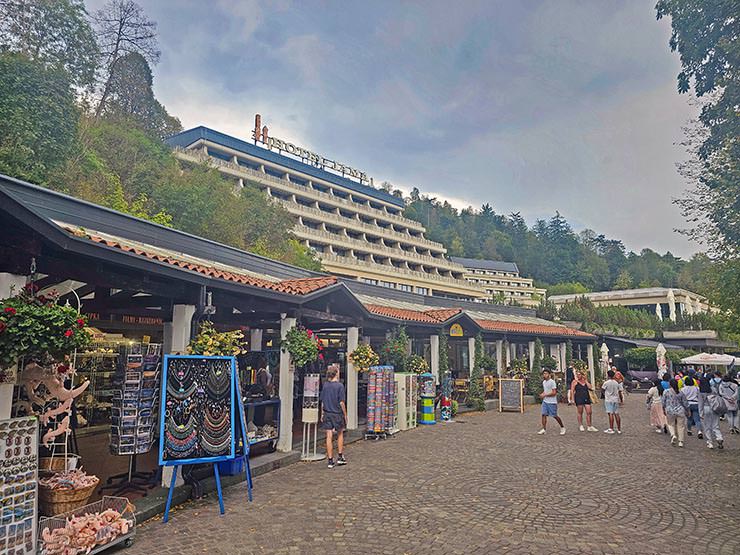
Hotel Jama history
Construction on Hotel Jama (pronounced ‘Yama’, meaning ‘Cave’) began in 1969, above Postojna Cave’s train garage.
Back then, Slovenia was just one of six republics forming Yugoslavia, a federation that was voting for its parliament that year.
Students in Ljubljana were chanting for political freedoms and social reforms, protesting everything from the Vietnam War to non-democratic regimes like the one in Greece.
It was an era of resistance, and rebellion, and Rade Šerbedžija starring in “Sedmina”, a drama where wartime Ljubljana was turning a boy into a killer.
Two years flew by, and by 1971, while Americans were marveling at the grand opening of Walt Disney World‘s Magic Kindom in Florida, socialist Slovenia was busy cutting the ribbon on its own crown jewel – Hotel Jama.
Yugoslavia was led by Josip Broz Tito, a charismatic political figure who didn’t want to take sides in the Cold War between Western capitalism and Eastern communism.
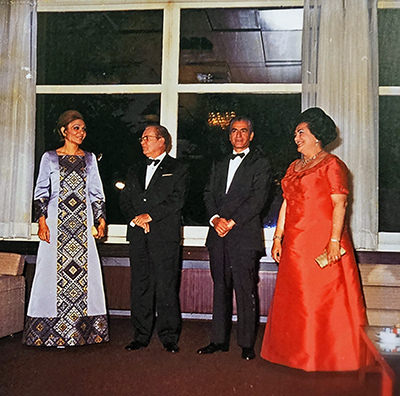
In the early 1970s, despite Tito’s whip hand, Yugoslav republics were slowly gaining greater autonomy within the federation. This was especially true in the economy, which was booming.
Freedom of speech was still under construction, much like the hotel. In 1971, Slovenia first forbade, then released with censor intervention, Boštjan Hladnik‘s movie “Maškarada”, an erotic drama about the indulgent lives of the rich elites.
Simultaneously, the opening of the Hotel Jama, with its luxurious, state-of-the-art facilities, was one of Yugoslavia’s efforts to portray itself as part of a modern and progressive world.
And it worked. The hotel became an instant hit, significantly boosting tourism development in Postojna, equally attracting high dignitaries and curious folks to Europe’s largest show cave.
Besides the natural wonder itself (Postojna Cave entertained 39 million visitors over two centuries), the man-made Hotel Jama helped establish Postojna as a major tourist hotspot.
The secret rooms of Hotel Jama
Decades of use had taken their toll on Hotel Jama. By 2009, the once-glamorous hotel was a shadow of its former self, its facilities worn down and its reputation in tatters. The hotel closed its doors, bankrupt, and in dire need of a transformation to meet modern standards.
The renovation work lasted over six years, three times longer than the time it took to erect the hotel from scratch. When it seemed the 8-million-euro facelift neared completion, the plot twisted.
Bothered by a solid steel door in the inner courtyard that construction workers did not change because no one had a key, Marjan Batagelj, the CEO of Postojna Cave company, ordered cutting through the lock.
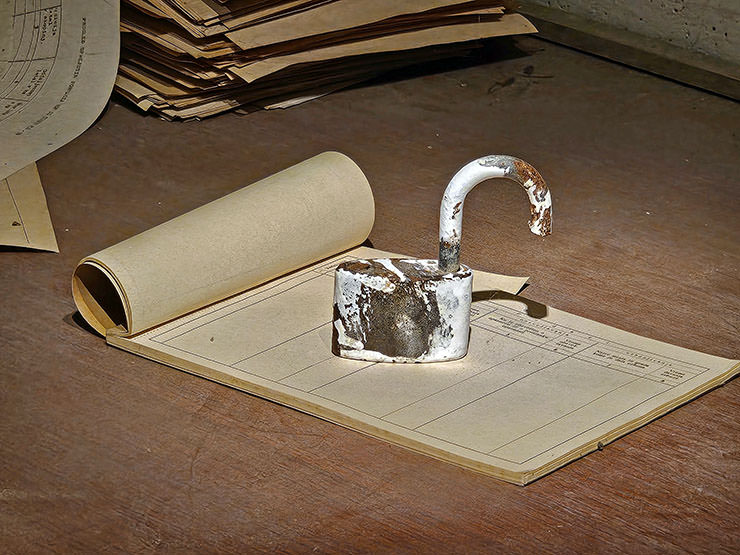
When the door was breached in 2016, they stepped inside and found hidden spaces filled with kilometers of dusty wiring, reels of audio tapes, and stacks of paper logs. These were remnants of a secret communication center, deserted and forgotten since 1991, after the ten-day Slovenian War of Independence marked the start of Yugoslavia’s breakdown.
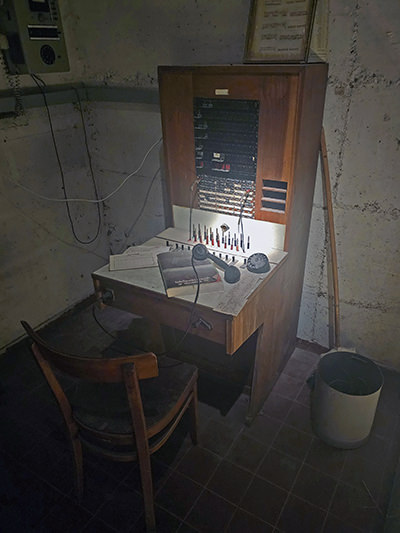
It turned out that, aside from today’s official 156 units, Hotel Jama also had secret chambers all along, rooms and passages hidden from the public eye. Those who ran covert operations from this shadowy underbelly of Cold War intrigue successfully kept their mission confidential for decades, behind tightly sealed lips and doors.
But why would the former regime station such an elaborate spy system in a luxury hotel? Built at a well-connected and strategically significant Postojna Town, a place with a military base, Hotel Jama practically had a guaranteed influx of important political figures. These were probably prime targets of surveillance operations.
What did the most prominent politicians talk about? We won’t find that out just yet. Before hotel representatives could even swift through the Secret Rooms, a squadron of police officers and secret service agents thoroughly combed through the materials abandoned since the communist times.
Hibernation headquarters – cave-inspired comfort
In Hotel Jama’s revamped guest rooms, however, there were no secrets, but more openness, and – choice.
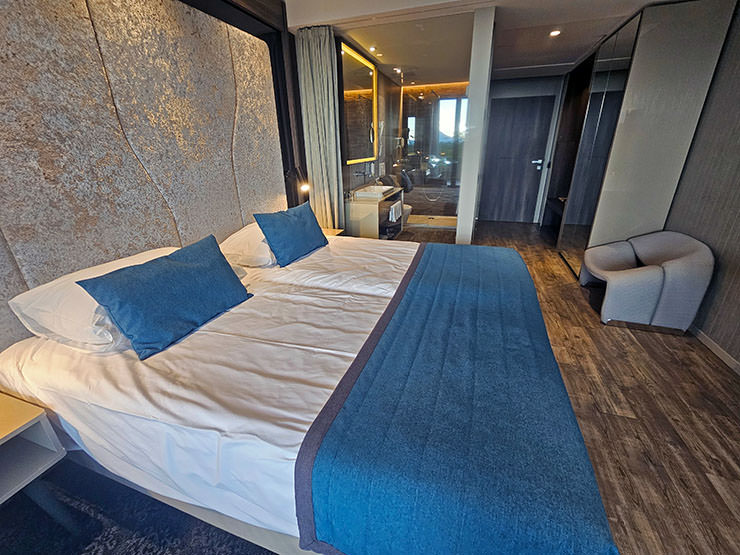
Space dominated by a plush double bed and velvet-like headboard extended into a mirror-covered wardrobe, as well as a glass-walled en-suite bathroom. For those who believe not all intimate moments should be exposed to natural light and audience, the bathroom could be curtained off, ensuring privacy during a toilet break or eyebrow-plucking in front of a vanity mirror.
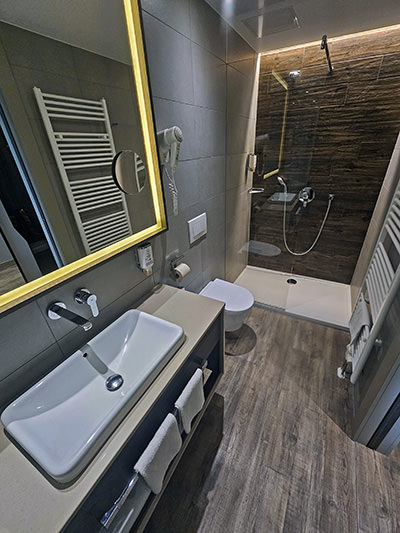
The stylish walk-in shower was half-screened by a frameless shower glass panel, continuing the idea of removing visual obstacles in the flowing space. In my case, the shower screen was not fully efficient in keeping the water inside; instead, it was leaking into the toilet zone with every usage. They didn’t have that in the 1970s when practicality took precedence over aesthetics.
To be fully transparent, this concept of appreciation for see-throughness was embraced via the spacious room terrace too. Outfitted with two chairs, a table, and an ashtray (don’t use the last one, for a full nature immersion), the balcony was practically an extended living room. Large sliding glass doors separated the outside from (or – connected it with?) the inside, letting in the verdant charm of Postojna’s surroundings and, via the warm wooden flooring, practically bringing the forest into your lap. There was also a flat-screen TV on the wall, but next to such enjoyable nature vistas, I was never tempted to even turn it on.
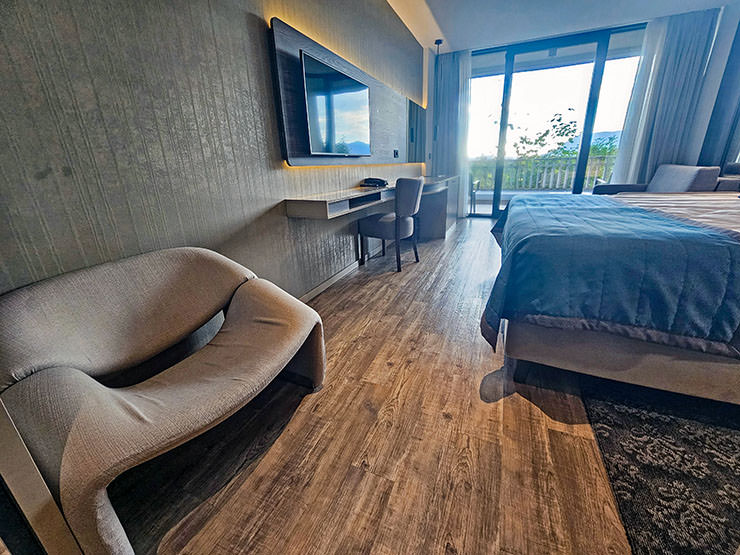
The elegant room interior was colored in neutral gray and beige tones, practically mimicking a cave, and creating a soothing “hibernate-here” vibe. Green blackout curtains were promising a good night rest, while hints of blue popped up in accents like decorative pillows and a bed runner.
Postojna Cave’s mascot, the olm (Slovenian “human fish”, or “baby dragon” as the locals like to call it), made cameo appearances in the form of room details, like pencils and door handles.
All of this was a result of the renovation that aimed to employ local authenticity while adopting minimalist yet modern interior design solutions.
Browsing history and mystery at Hotel Jama
If you’re the type who needs to squeeze in some work between spelunking and secret-room sleuthing, Hotel Jama’s rooms have you covered. The mini sofa, armchair, or even the desk chair at a long workstation, all make for solid spots to plop down with your laptop.
But as you connect to the Wi-Fi, a little message pops up on your screen: “Other people might be able to see info you send over this network”.
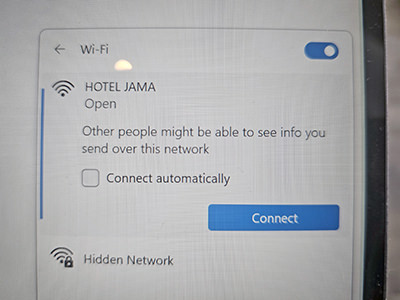
For most, this standard Windows warning about open networks’ vulnerability to interception is easy to ignore. But here, at Hotel Jama, where Secret Rooms were advertised as an interactive documentary experience on everything from in-room leaflets to DND hotel signs (“Pssst! Discover the former regime’s mystery of Hotel Jama”), the alert of a cybersecurity threat easily got a new layer of reading. Was this just a mostly harmless lack of encryption, or was someone, somewhere, watching you Google “the secret rooms of Hotel Jama”?
Feeling a touch paranoid, you might pick up the room’s telephone, ready to call the front desk for more info, as that was exactly what all these ads suggested you should do.
On the room telephone you read a note that the device could connect you to other rooms, but “international and local calls can be made at the reception”. This was planting another seed of doubt – would they be monitoring you if you headed down to the front desk to place a call?
If you are really worried about surveillance at your vacation rental, get familiar with places people hide hidden cameras and microphones!
Something to hide
While I waited in the hotel lobby, which over the years saw so many distinguished guests (some memorized in photographs encased in wooden frames on the walls), I noticed a bookshelf with mostly Slovenian and English titles and a few lonely Dutch and Korean works.
There was an empty space within this collection. A missing book. In the same pattern I saw with room numbers playing hide-and-seek, one title seemed to be gone.
But the book wasn’t taken away, just shoved to the back of the shelf. It reminded me of my childhood visits to the library in the last years of Yugoslavia. Faced with the strict three-book borrowing limit, I used this exact tucking method to hopefully protect some limited wish-list titles from leaving the shelf before my next library visit. It was selfish, I know, and probably not even effective.
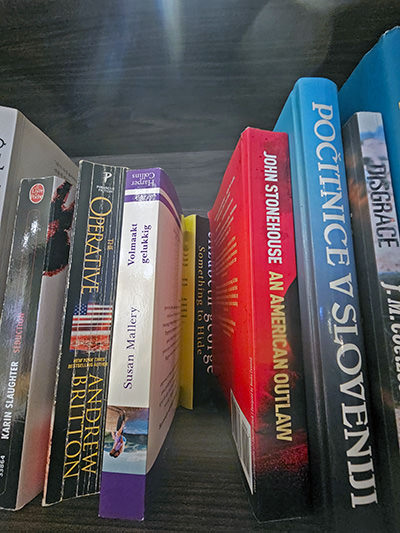
To atone for my silly childhood sins, I reached into the book gap, and pulled out Elizabeth George‘s mystery novel “Something to Hide”. Oh, come on! That had to be intentional, right?
As I returned this book about detectives sorting through people’s secret lives to its rightful place, I half-expected the shelf to swing open, revealing a secret passageway – that’s how charged for a Bond-style adventure I was!
But no hidden door, just Kevin Klun Valenčič appeared before me, a tour guide who would take me on a journey through the double life that Hotel Jama lived during its three communist decades.
Kevin was never there, though. A young man who would lead me through the intrigues of the former regime, was born in 1991, when Slovenia proclaimed independence, and Secret Rooms got abandoned.
It was also the year when Oliver Stone‘s “JFK” would come out, a movie where Kevin Costner played a district attorney investigating a conspiracy behind President Kennedy‘s assassination.
Named after the popular movie star, my guide seemed destined to untangle the webs of intrigue and espionage.
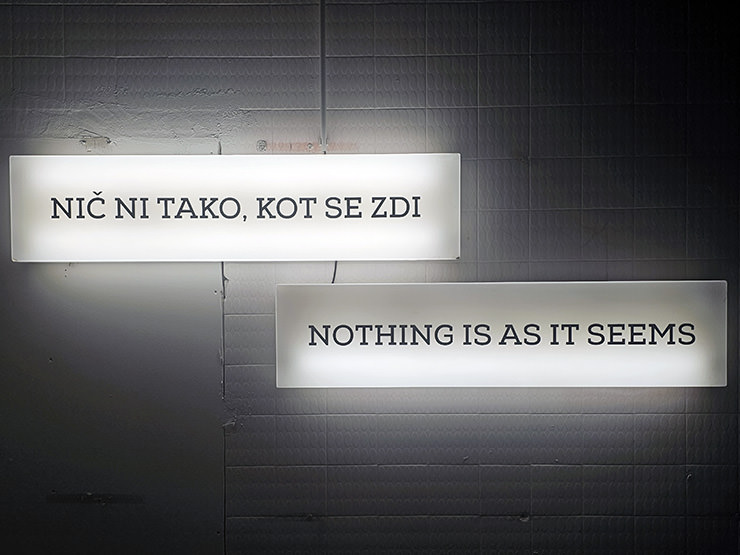
A doorway to deception
Our adventure began on the first floor, where a magnetic key unlocked the door to Room 1117. Inside, an empty space, with just a neon sign flickering “Nothing is as it seems”.
In front of the room, a TV screen was showing something radically different – a snapshot of a retro-style ambient.
Back in the 1970s, this floor wasn’t some cryptic minimalist art installation. It was a buzzing lounge/restaurant, radiating glamour and sophistication. With clean lines, bold orange armchairs, hanging globe lamps, and geometric ceiling patterns, the interior reflected the modernist style popular in Yugoslavia at the time, blending function with understated luxury. It was a perfect space to play the role of a cosmopolitan meeting point for diplomats, scientists, and other high-profile guests.
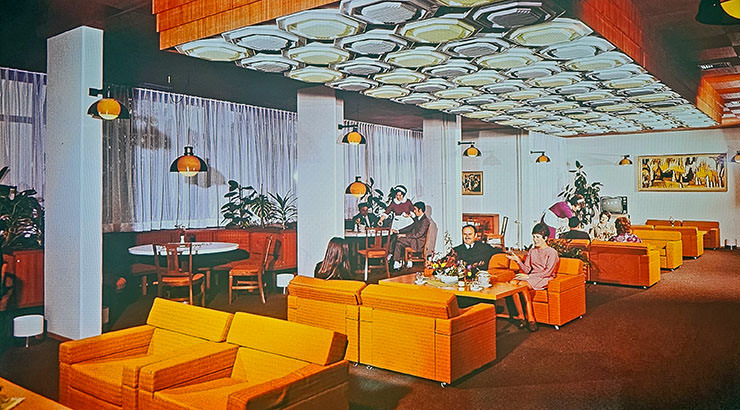
You could practically imagine Hotel Jama’s public spaces buzzing with sounds of lively conversation and clinking glasses. Guests basked in the hotel’s warm, inviting atmosphere, blissfully unaware of the monitoring operations in the secret rooms beneath their feet.
But how did this surveillance hub blend so seamlessly into the hotel’s infrastructure, ensuring that no guest (or even most staff) would suspect its existence?
Next to the hallway’s fire extinguisher, we spotted Room 1118 and opened the door we would never exit through.
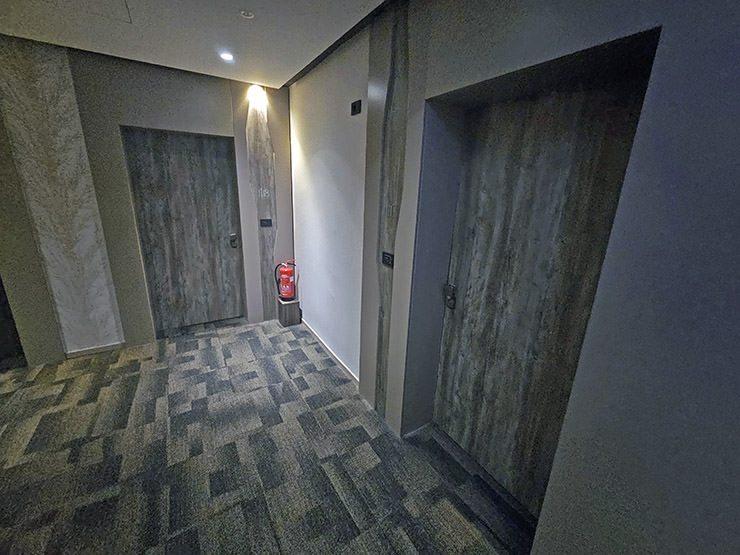
Big Brother’s bar
The entrance corridor displayed vintage Postojna Cave tickets, faded tourist maps, and even tourist glossaries, all evoking nostalgia. But already the next room was scaring you off with the bygone era.
Six vivid red bar stools were lined up, but no barista in sight. It was a self-service bar that offered no cocktails – only a free flow of conversations would pour into our ears. The telephone switchboard-resembling devices were practically time machines enabling fly-on-the-wall gossip experiences.
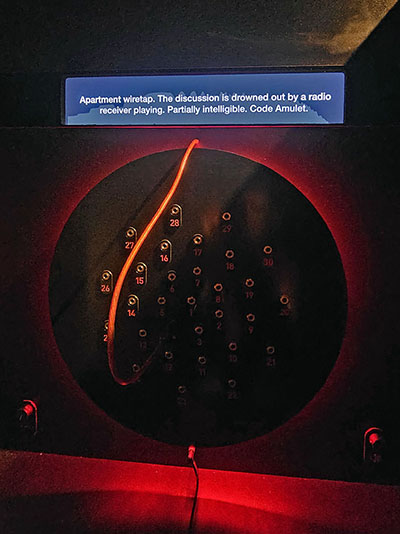
The Slovenian secret service had declassified 30 wiretapped conversations from the communist period, and manual cord switching allowed us to listen in.
“Yes, we’ll be having cabbage”, said one guest.
“Cabbage. Then there’s no need for a salad”, replied the other one.
“Anything to drink?”, a waiter asked a question I would not hear only once that evening.
There was not much context given to the recordings in this audio buffet, leaving it up to listeners to interpret whether innocent exchanges were caught in the web of surveillance, or we were hearing the lingo of spies, possibly even double agents.
Conversation 25. Two female voices on the phone, arranging a cinema date. They would watch “Lawrence of Arabia” with Omar Shariff and Peter O’Toole. But they planned to meet 15 minutes before the projection, so that they could have “a nice slow stroll to the movies”. Their convo sounded suspicious, and if they knew their phones were bugged, a public space rendezvous would’ve probably enabled an exchange without the need for a spy dictionary.
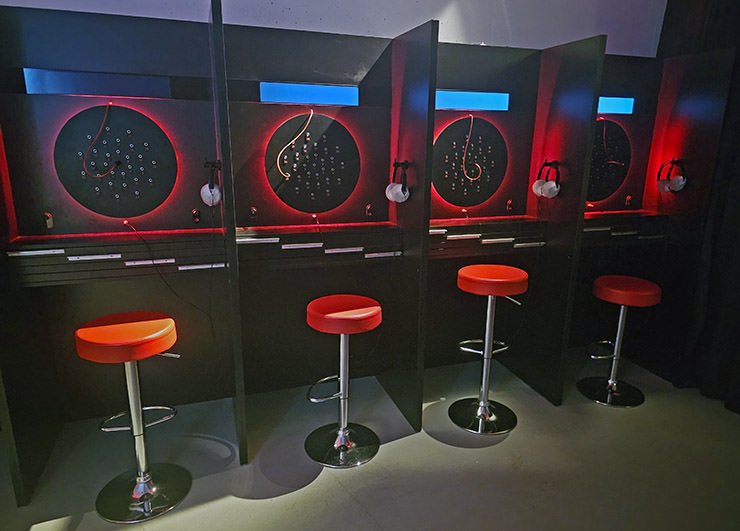
In these “Big Brother” times, listening to old conversations could be oddly addictive. Even when the recordings revealed nothing more than dietary preferences or social plans, the experience let us enter the spy’s shoes. Their listening jobs, in the pre-AI century, surely involved long hours of boredom before they would catch a juicy lead worth exploring further.
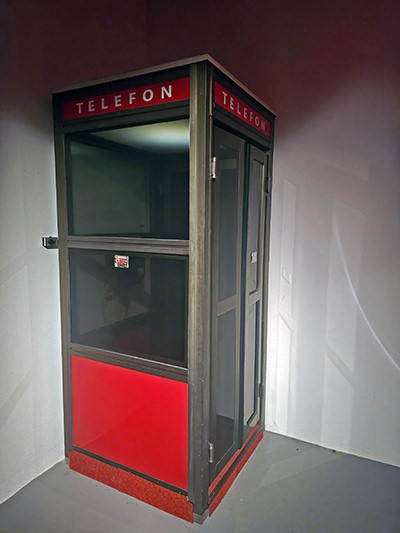
Hotel Jama’s secret passage
A vintage red phone booth in the corner of Room 1118, a relic of the analog era, had Narnia-style capacity. Picking up the rotary-dial phone didn’t just summon the voice of a mysterious stranger on the other side of the line. After playing with a monitoring paranoia, the instruction said: “Step through!” And I obliged.
Retro telephone receivers hanging from the ceiling, teasingly out of reach, and another neon sign on a bare concrete wall (this time flashing a philosophical warning “It’s all true / a lie”) were the next installations reinforcing the earlier notion that we shouldn’t always trust the first impression.
“When someone says that something is 100% true, or 100% a lie, that simply isn’t true”, Kevin said, making my brain freeze in the loop.
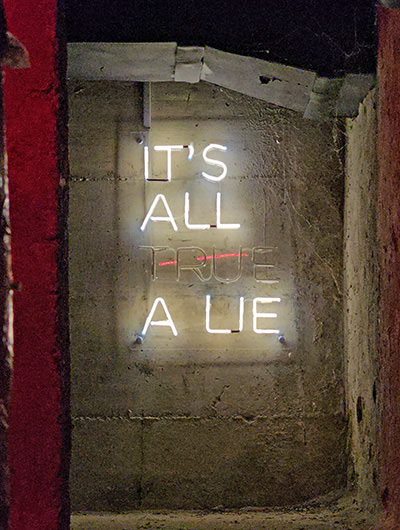
“I want to believe”, Fox Mulder in me whispered through. But, with no Superman-style phone booth quick change, I was still just a journalist on an assignment, practically Clark Kent in an alien world. Or even more precisely – the underworld.
Like in Doctor Who‘s TARDIS, Hotel Jama’s time machine was also “bigger on the inside”. A secret staircase unfolded behind the booth, leading deeper into the hotel’s hidden architecture. This was no ordinary staircase. It cut through double walls and concealed corridors that had seen more secrets than an incognito browser window.
The telephone booth was, of course, a modern gimmick. In the past, when the first floor hosted a restaurant, the backstage exit probably had a more practical disguise.
You could come to work your waiter’s shift in a quiet hotel but then step into a portal to spy operations. The ordinary hotel staff could transform into covert operatives.
Just like for me on the visit day, this seemed to be a one-way road; once you were exposed to deep-buried secrets in the bowels of the hotel, there was no coming back.
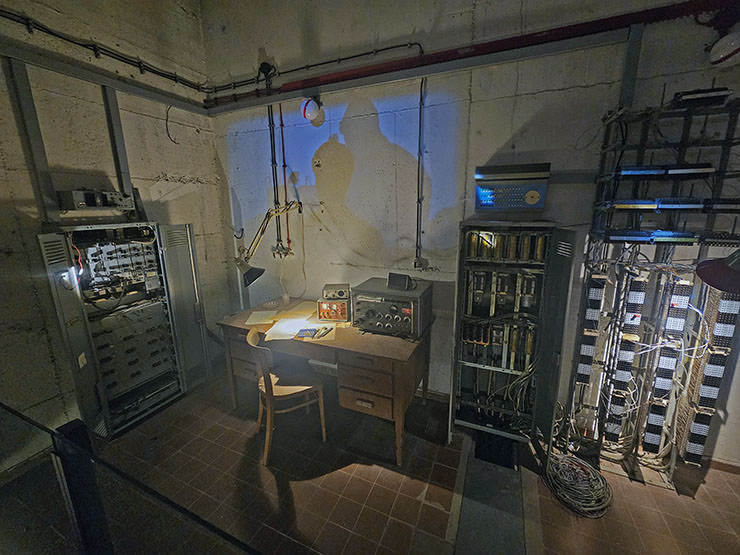
Inside the spy bunker
The bottom floor of Hotel Jama revealed a treasure trove of 20th-century gadgets. The four rooms were fitted with typewriters, listening equipment, radios, and complex telephone contraptions, with a red phone line enabling secure connection directly with Belgrade, the Yugoslavian capital.
Concrete walls and exposed wiring emphasized the nature of this space – it was designed for function, not aesthetics.
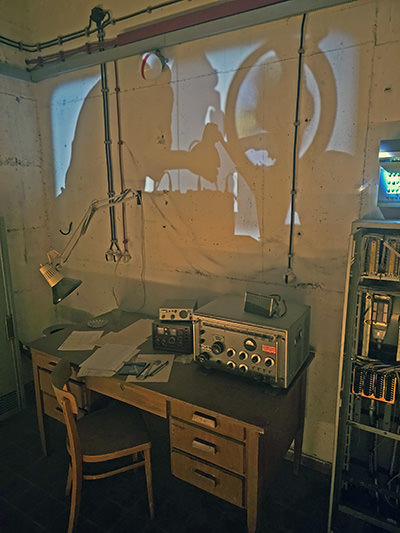
Everything was presented in a state that it was found in, and how UDBA, the State Security Service of Yugoslavia, left it, with bottles, newspapers, and other period knickknacks. The staging of the scene included a thick layer of dust on furniture.
You could picture the operators, hunched over their desks under adjustable table lamps, ears pressed to headphones, and eyes scanning endless paper reports.
The lack of windows meant there wasn’t even a hint of daylight to remind them what hour it was. The enemy never slept.
Of course, exhaustion would inevitably hit, shutting their eyes and ears. A gallery-level bed offered a rare reprieve. We could only peer at this spy nap station through a mirror, as climbing up was not permitted. Only secret agents were entitled to siestas there.
There’s no good intelligence work without a clear mind, after all.
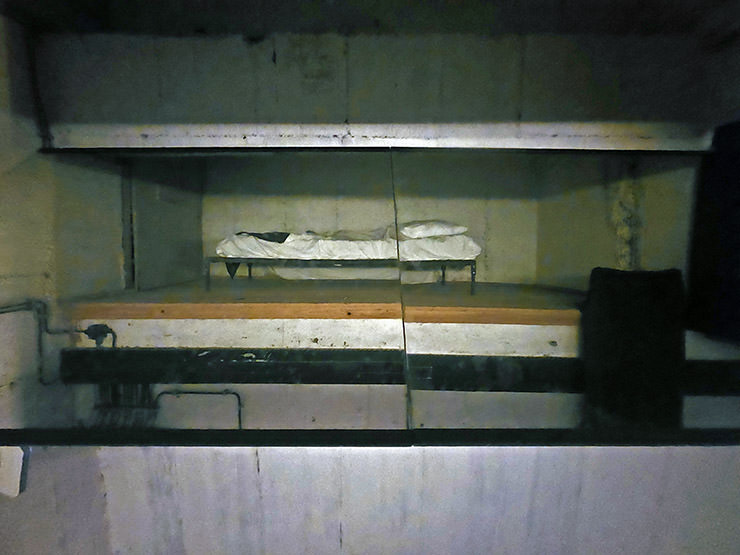
Escape route from Secret Rooms – you can run but you can’t hide
As we walked through this spy cave, a nerve center of analog intelligence, designed for surveillance and eavesdropping, we listened to the only audio recording actually found among the information rubble in these rooms. It was a military-coded report, cryptically rattling off numbers and coordinates of occupied territories, delivered by an operative identifying himself as “Planina 1”.
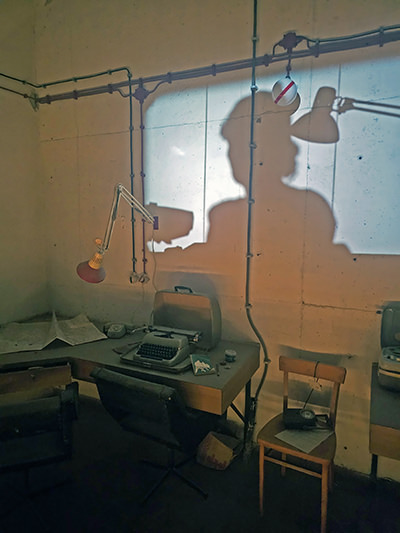
On the walls of this espionage hub, the shadows of typists were working hard to transcribe the mumbo jumbo into actionable intel.
At the end of their working shift, agents could just easily walk a half-floor up via the same staircase, and vanish through a secret exit – a dressing room connected to a train garage/maintenance room. From there, they could slip into Postojna Cave, and blend in as ordinary visitors among the crowds.
My tour of the Secret Rooms ended at Hotel Jama’s lobby, right where it began. Kevin handed me a brown-paper folder stamped “strictly confidential”. Inside was a file, surveillance number 067/1.9, marked as intended only for the eyes of the President and his inner circle. I certainly hoped Kevin would not get into trouble for sharing it with me!
The file described the suspicious behavior of a “visitor” who had been snooping around, asking “too many questions”. The report said that the supervised individual disappeared from monitoring control while in the telephone booth. There were no details of the incriminating call, but the photograph of the suspect was attached. It was me, snapped through a peephole in the phone booth.
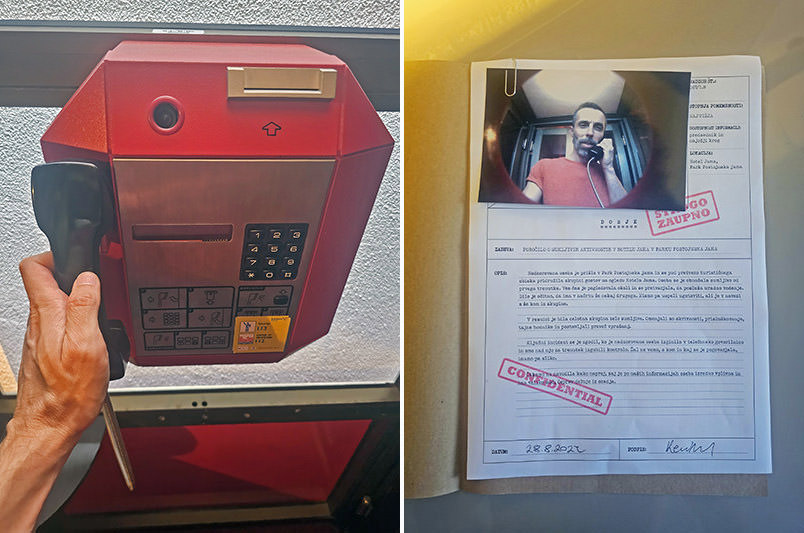
A meal worth investigating
That was the problem of the times. You never knew who was a regular employee, a random visitor, or possibly an agent with a secret mission. The best spy would never (or always?) leave space for doubt.
After the entire experience of Secret Rooms, my radar for potential undercover operatives sharpened up.
There I was, enjoying the buffet dinner at the hotel’s Magical Garden restaurant. As I nibbled on a delicious Carniolan sausage (Kranjska klobasa, Slovenia’s pride and joy), a young waiter approached me.
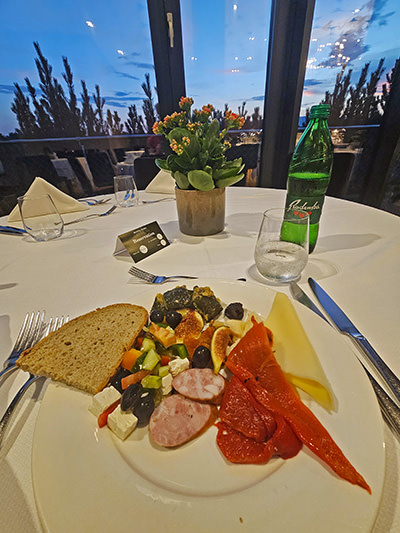
“Anything to drink, sir?”, he asked, and I froze mid-bite. Déjà vu hit me.
“No, no cabbage for me”, I wanted to say while his lips moved. But I was more drawn to his groomed handlebar mustache, such an obvious reference to Hercule Poirot. Oh, are we getting detectives, again? Is there another mystery coming up?
The waiter tried to upsell wines, but as someone who spent a summer working for a wine hotel, I again had, if I can quote that not-so-secret report, “too many questions”.
“What type of wine is your house wine?”, I asked.
“We have red and white, sir”, he replied.
“Yeah, but what grapes go into it?”, I said, and the question launched an avalanche of question marks in his gaze. “You know, for these other wines, the menu specifies Chardonnay, Merlot, Pinot… But what is Krasno belo or Krasno rdeče exactly?”
“Hm, I’d have to check, sir”, his mustache twitched. “But I can say that these are all like French wines, but produced here, in Slovenia.”
I didn’t want my Poirot waiter to sweat further, so I just went for local Radenska (Slovenian mineral water, produced in Slovenia), and decided to keep my mouth shut. By stuffing it with food.
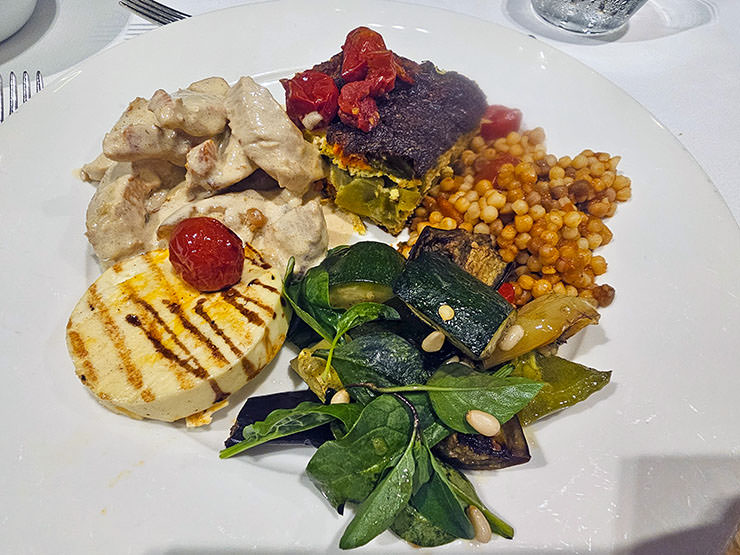
For a buffet, the offer was quite solid. I enjoyed a creamy squash soup, grilled cheese with roasted tomatoes, zucchini with baby spinach and pine nuts, vegetable casserole, fregola sarda with Mediterranean veggies, and turkey strips in the cream-peanut sauce.
The salad bar was respectable, though the dessert was a bit sparse – just two cakes (custard-cream, and fruit panna cotta). Thankfully, there were fruits and ice cream for backup.
The restaurant itself was elegant, with chandeliers and all, its large glass walls framing the golden hues of sunset. I let the spy universe rest and focused on enjoying good food in a beautiful setting.
A morning in the shadows of Yugoslavia
Besides dinner-time Radenska with three hearts (each representing the nations of the former Kingdom of Yugoslavia: Serbs, Croats, and Slovenes), breakfast also brought a nostalgic trip down the YU-flavored memories.
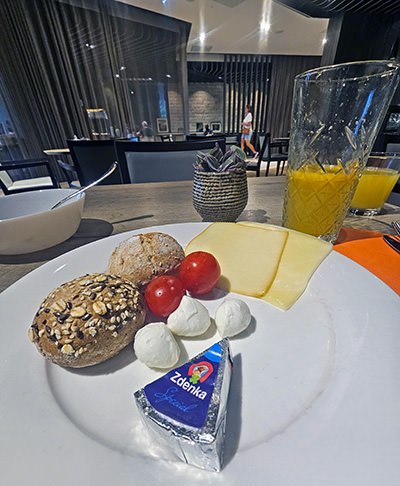
If you wanted to taste local, Hotel Jama allowed you to appreciate the traditions from the other side of the border too. Skip President cheese, and try the creamy Zdenka instead; this Croatian processed cheese comes with a century-old tradition!
Another iconic food product on Hotel Jama’s morning menu was Čokolino, the chocolate-flavored breakfast cereal that has been comforting the region’s kids (and, let’s be honest, adults) for half a century. Vegan and lactose-averse guests could mix this ready-to-eat porridge with soy or rice milk.
Of course, there was also an expected selection of cold cuts and cheeses, croissants, and fruits, some sweet cheese pies, and leftover panna cotta from dinner.
Besides the usual coffee and tea, the drink station was offering four juice varieties – orange, grapefruit, apple, and green. While the servers were rushing around proudly displaying a Slovenian flag on their shoulder, I wanted to ask them about what went into the “green”. But in the end, I settled for orange juice.
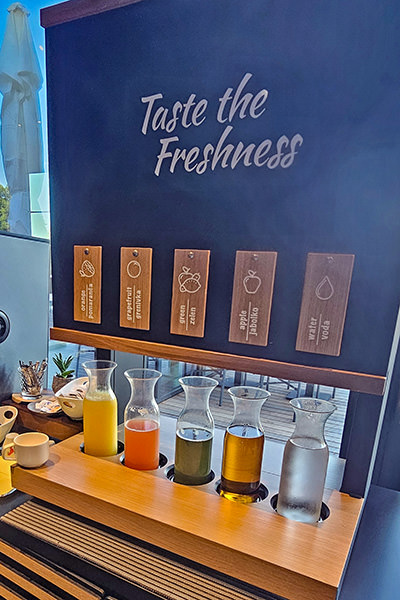
Despite the prominent sign shouting “Taste the Freshness”, these were clearly just rebottled industrially-processed tetrapak juices.
I asked the waitress if it was possible to get a freshly squeezed orange juice, and she confirmed. Sadly, what arrived was a disappointingly watered-down version of what one would expect to get when ordering such a staple breakfast drink at a 4-star hotel.
The breakfast menu at Hotel Jama clearly had some intriguing ideas that complemented the overall concept of a modern hotel built on the cornerstone of the past, but it also had a lot of (not-so-secret) room for improvement.
Adrenaline underground – from hidden rooms to bat treks
Hotel Jama definitely provides comfort right at the entrance of Postojna Cave, one of Slovenia’s largest tourist attractions. If you book a room here, you can count on the convenience of free parking, but also the vicinity of all the things to do.
Besides the basic cave visit, you should take a peek into the Vivarium (where you can meet cave critters that could double as alien extras in a sci-fi flick), and the EXPO Cave Karst exhibition (a deep dive into secrets of geology).
But also, join more than one guided tour! I enjoyed my private Postojna Cave visit with the guide Stanislav Glažar, who seemed to know every stalactite by name. I also learned a lot during the group Trek through Three Caves (Postojna, Pivka, and Black Cave) led by the enthusiastic Peter Gorjup. But the highlight of my underground experiences in Postojna was the adrenaline-pumping trek through the Cave under Predjama Castle with an expert cave navigator Nejc Prinčić and some sleepy companions hanging around – a colony of bats.
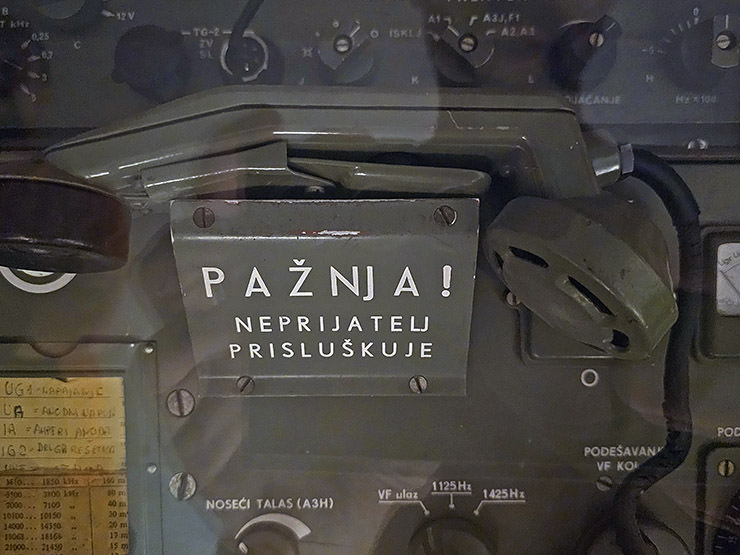
As for Hotel Jama itself, it did lack some almost expected amenities, such as a spa, or at least a small gym. Maybe Room 1117, instead of just being a storage for a neon sign, could moonlight as a fitness corner? Just a thought.
But what the hotel lacked in treadmills, it compensated by leaning on intriguing and immersive tour experiences. Secret Rooms tour was certainly one such smart project.
I loved being escorted by my tour host Kevin, a dedicated spy storyteller. Yet, having previously tried the self-guided tour too (with an audio guide, and a photo ban), I must admit I preferred the strict loneliness, where questions could remain unanswered. There’s something undeniably thrilling about wandering the unknown halls in secret agent mode, with instructions whispered right into your ear.
If you want to pick Hotel Jama as your Postojna accommodation, you can reserve your stay via Booking or Agoda. But more often than not, you can find even better conditions on Trip. Compare all the prices for your booking dates, and pick the most affordable one! For even more reviews of Hotel Jama, head to the dedicated Tripadvisor page.
Conclusion – The Renaissance of Hotel Jama
With its roots as a relic of a bygone political era, Hotel Jama managed to evolve into something far more captivating than just a Brutalist icon with cascading tiers and sharp geometric lines that evoke an aesthetic of efficiency and order.
This building that seamlessly blends into the rocky terrain of Postojna, almost like a natural extension of the famous cave system it was designed to serve, showed that there was an afterlife to totalitarian and utilitarian 1970s when overt purpose (tourism) and covert function (state security) coexisted under the same roof. One was greeting guests with brochures and buffets, the other eavesdropping on whispered conversations through miles of hidden wiring.
With a welcoming facade and vibrant outdoor terraces contrasted with its hidden secret, Yugoslavia made an effort to present a hospitable, progressive image while maintaining its strategic defenses.
Secret Rooms were a space where information flowed in only one direction and nothing was meant to leave. The new hotel management ebraced something radically different
Fast forward to the present, Hotel Jama has been renovated to meet contemporary standards, from softer landscaping of greenery, ornamental grasses, and colorful flowers, to clean minimalism of interior design and energy efficiency. However, it still remains a unique monument of previous times, with history as a central part of its allure.
The Secret Rooms were a space where information flowed in only one direction and nothing was meant to leave. The new management embraced something radically different – transparency (both literal, with glass walls flooding rooms with natural light, and metaphorical, by revealing the hotel’s secretive past).
The truth is out there. Well, so is the lie, as the neon sign so sincerely confessed. In tourism, where marketing success is measured by stories that sell, even the greatest fantasies can become lucrative realities.
Hotel Jama reminds us that the unseen – the untold – is often what lingers longest in our minds.
Did you like this review of Hotel Jama in Postojna and its Secret Rooms?
Leave your comments below, and pin the article for later!
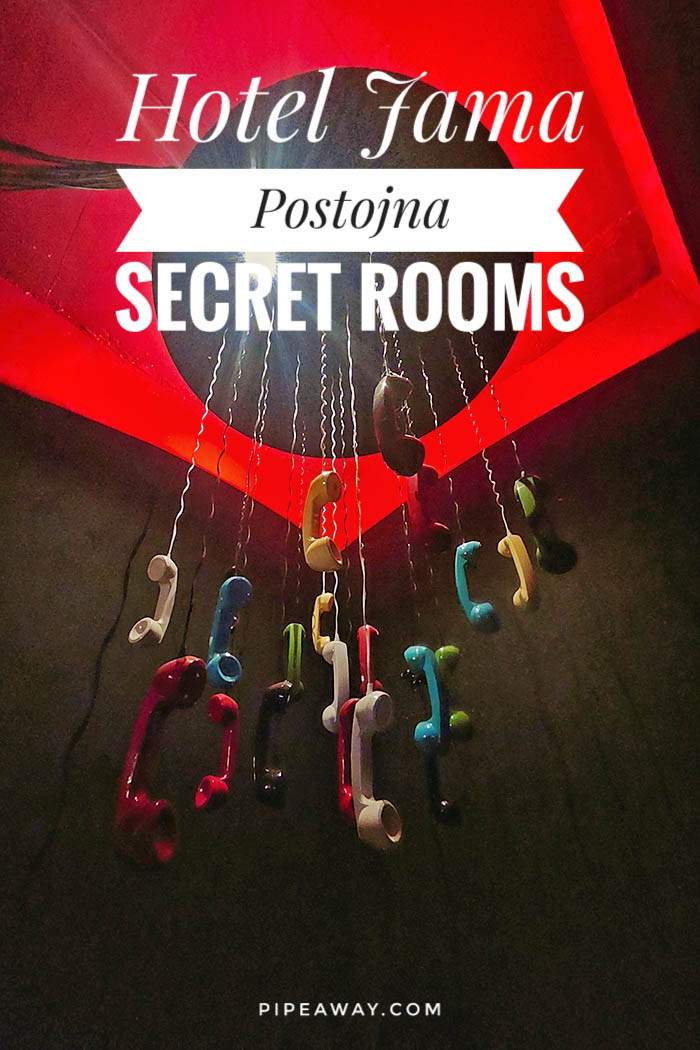
Disclosure: My stay at the Hotel Jama was complimentary, but all opinions are my own. Also, this post may contain affiliate links, meaning if you click on them and make a purchase, Pipeaway may make a small commission, at no additional cost to you. Thank you for supporting our work!

